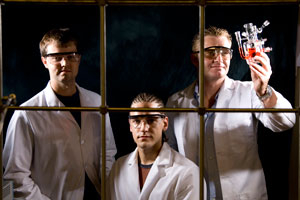Imagine owning a vehicle engineered to pack as much as three times the fuel efficiency of cars on the road to date. A car designed to gain its propulsion by way of an electric motor, running on electricity generated by a fuel cell and emitting only water from its exhaust.
Throughout the last three years, researchers at the University of Houston Cullen College of Engineering have teamed with individuals at Stanford University and the Stanford Linear Accelerator Center, a national laboratory operated by the California-based university for the U.S. Department of Energy, to engineer components that could mass produce just such a car.
In their short time together, the research team has discovered a method to create a less expensive, more efficient polymer electrolyte membrane fuel cell.
“We have developed an improved catalyst concept, which would dramatically reduce the platinum amount and the cost of hydrogen fuel cells,” said Peter Strasser, an assistant professor in UH's department of chemical and biomolecular engineering and co-investigator on the research project.
The method dilutes pure platinum – an expensive metal used in most fuel cell catalysts – and combines it with other metal alloys such as palladium, cobalt and copper. The combination is far more efficient than pure platinum catalysts, which can experience diminished performance over time, Strasser said.
Though current grant funding ends in August, a nearly $2 million extension from the U.S. Department of Energy received by the team this spring will support continued research on perfecting the catalyst design.
“The extension is based on our encouraging results,” Strasser said of the three-year project, one of four involving fuel cells currently underway for the researcher. “It will extend research into why these catalysts work and whether the principle could be applied to other catalysts.”
The group’s fuel cells allow chemically stored energy to be converted into electrical energy without combustion by way of two different reactions.
On the anode side of the cell there is an oxidation reaction causing hydrogen molecules to split into pairs of protons and electrons. The polymer electrolyte membrane in the center of the cell allows positively charged protons to travel through to the cathode side, where an oxygen reduction reaction occurs and the electrons, which traveled through the outer circuit producing the electric current, along with atoms of oxygen combine with the protons to create water.
The initial project, funded with an amount similar to the recent grant extension by the U.S. Department of Energy, was ranked among the largest of President Bush’s Hydrogen Fuel Cell Initiative – aimed to reverse America’s growing dependence on foreign oil through the development of technology needed for commercially viable hydrogen-powered fuel cells.
The progress already made by the research team along with their future efforts in the creation of a more efficient hydrogen fuel cell could not only impact transportation, but equally help power portable devices, even homes with the technology.
“The idea is definitely for a more hydrogen-based economy,” Strasser said. “If hydrogen could play a more important role in our transportation infrastructure this could help ease the oil dependency. Now nobody expects that hydrogen will replace oil in the near future, but even if we can get a small start, followed by a continuous growth that would help.”
